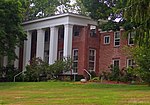Storm King Art Center
1960 establishments in New York (state)Art museums and galleries in New York (state)Art museums established in 1960Cornwall, New YorkMuseums in Orange County, New York ... and 4 more
Open-air museums in New York (state)Outdoor sculptures in New York (state)Sculpture gardens, trails and parks in New York (state)Use mdy dates from August 2018

Storm King Art Center, commonly referred to as Storm King and named after its proximity to Storm King Mountain, is an open-air museum located in New Windsor, New York. It contains what is perhaps the largest collection of contemporary outdoor sculptures in the United States. Founded in 1960 by Ralph E. Ogden as a museum for Hudson River School paintings, it soon evolved into a major sculpture venue with works from some of the most acclaimed artists of the 20th century. The site spans approximately 500 acres (200 ha; 0.78 sq mi), and is located about a one-hour drive north of Manhattan.
Excerpt from the Wikipedia article Storm King Art Center (License: CC BY-SA 3.0, Authors, Images).Storm King Art Center
Museum Road, Town of Cornwall
Geographical coordinates (GPS) Address Nearby Places Show on map
Geographical coordinates (GPS)
| Latitude | Longitude |
|---|---|
| N 41.42514 ° | E -74.0593 ° |
Address
Museum Building
Museum Road
12518 Town of Cornwall
New York, United States
Open on Google Maps










